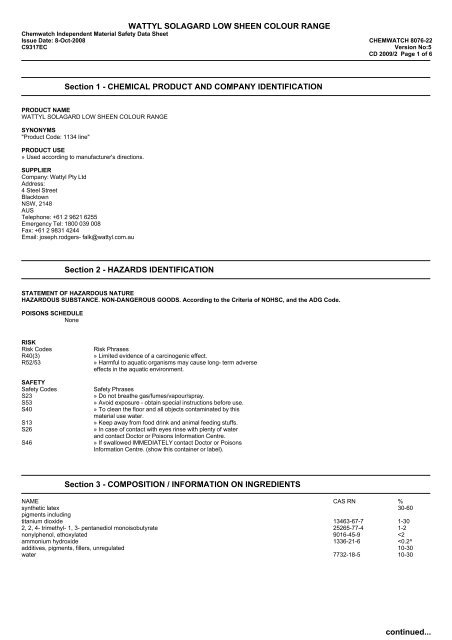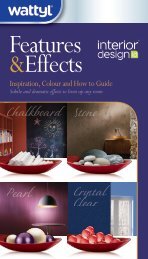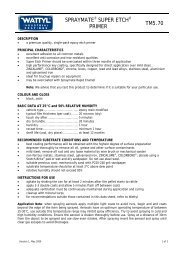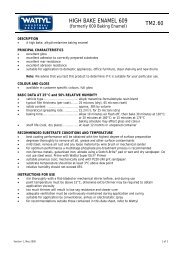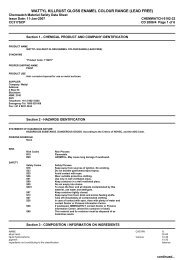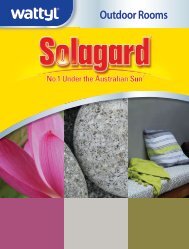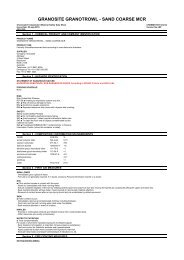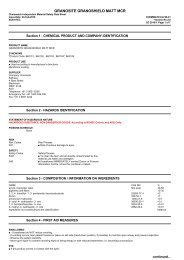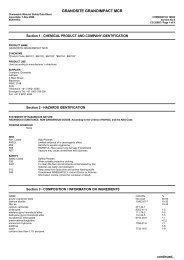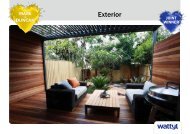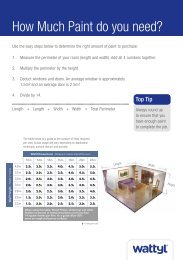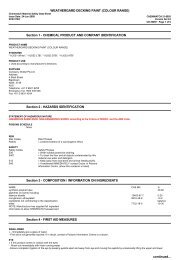SOLAGARD Low Sheen MSDS - Wattyl
SOLAGARD Low Sheen MSDS - Wattyl
SOLAGARD Low Sheen MSDS - Wattyl
Create successful ePaper yourself
Turn your PDF publications into a flip-book with our unique Google optimized e-Paper software.
WATTYL <strong>SOLAGARD</strong> LOW SHEEN COLOUR RANGE<br />
Chemwatch Independent Material Safety Data Sheet<br />
Issue Date: 8-Oct-2008 CHEMWATCH 8076-22<br />
C9317EC<br />
Version No:5<br />
CD 2009/2 Page 1 of 6<br />
Section 1 - CHEMICAL PRODUCT AND COMPANY IDENTIFICATION<br />
PRODUCT NAME<br />
WATTYL <strong>SOLAGARD</strong> LOW SHEEN COLOUR RANGE<br />
SYNONYMS<br />
"Product Code: 1134 line"<br />
PRODUCT USE<br />
» Used according to manufacturer's directions.<br />
SUPPLIER<br />
Company: <strong>Wattyl</strong> Pty Ltd<br />
Address:<br />
4 Steel Street<br />
Blacktown<br />
NSW, 2148<br />
AUS<br />
Telephone: +61 2 9621 6255<br />
Emergency Tel: 1800 039 008<br />
Fax: +61 2 9831 4244<br />
Email: joseph.rodgers- falk@wattyl.com.au<br />
Section 2 - HAZARDS IDENTIFICATION<br />
STATEMENT OF HAZARDOUS NATURE<br />
HAZARDOUS SUBSTANCE. NON-DANGEROUS GOODS. According to the Criteria of NOHSC, and the ADG Code.<br />
POISONS SCHEDULE<br />
None<br />
RISK<br />
Risk Codes<br />
Risk Phrases<br />
R40(3)<br />
» Limited evidence of a carcinogenic effect.<br />
R52/53 » Harmful to aquatic organisms may cause long- term adverse<br />
effects in the aquatic environment.<br />
SAFETY<br />
Safety Codes<br />
S23<br />
S53<br />
S40<br />
S13<br />
S26<br />
S46<br />
Safety Phrases<br />
» Do not breathe gas/fumes/vapour/spray.<br />
» Avoid exposure - obtain special instructions before use.<br />
» To clean the floor and all objects contaminated by this<br />
material use water.<br />
» Keep away from food drink and animal feeding stuffs.<br />
» In case of contact with eyes rinse with plenty of water<br />
and contact Doctor or Poisons Information Centre.<br />
» If swallowed IMMEDIATELY contact Doctor or Poisons<br />
Information Centre. (show this container or label).<br />
Section 3 - COMPOSITION / INFORMATION ON INGREDIENTS<br />
NAME CAS RN %<br />
synthetic latex 30-60<br />
pigments including<br />
titanium dioxide 13463-67-7 1-30<br />
2, 2, 4- trimethyl- 1, 3- pentanediol monoisobutyrate 25265-77-4 1-2<br />
nonylphenol, ethoxylated 9016-45-9
WATTYL <strong>SOLAGARD</strong> LOW SHEEN COLOUR RANGE<br />
Chemwatch Independent Material Safety Data Sheet<br />
Issue Date: 8-Oct-2008 CHEMWATCH 8076-22<br />
C9317EC<br />
Version No:5<br />
CD 2009/2 Page 2 of 6<br />
Section 4 - FIRST AID MEASURES<br />
SWALLOWED<br />
• Immediately give a glass of water.<br />
• First aid is not generally required. If in doubt, contact a Poisons Information Centre or a doctor.<br />
EYE<br />
» If this product comes in contact with the eyes:<br />
• Wash out immediately with fresh running water.<br />
• Ensure complete irrigation of the eye by keeping eyelids apart and away from eye and moving the eyelids by occasionally lifting the upper and lower<br />
lids.<br />
SKIN<br />
» If skin contact occurs:<br />
• Immediately remove all contaminated clothing, including footwear.<br />
• Flush skin and hair with running water (and soap if available).<br />
INHALED<br />
• If fumes or combustion products are inhaled remove from contaminated area.<br />
• Other measures are usually unnecessary.<br />
NOTES TO PHYSICIAN<br />
» Treat symptomatically.<br />
Section 5 - FIRE FIGHTING MEASURES<br />
EXTINGUISHING MEDIA<br />
• Use extinguishing media suitable for surrounding area.<br />
• There is no restriction on the type of extinguisher which may be used.<br />
FIRE FIGHTING<br />
• Alert Fire Brigade and tell them location and nature of hazard.<br />
• Wear full body protective clothing with breathing apparatus.<br />
FIRE/EXPLOSION HAZARD<br />
• The material is not readily combustible under normal conditions.<br />
• However, it will break down under fire conditions and the organic component may burn.<br />
FIRE INCOMPATIBILITY<br />
» None known.<br />
HAZCHEM: None<br />
PERSONAL PROTECTION<br />
Glasses:<br />
Safety Glasses.<br />
Chemical goggles.<br />
Gloves:<br />
PVC chemical resistant type.<br />
Respirator:<br />
Type AK-P Filter of sufficient capacity<br />
Section 6 - ACCIDENTAL RELEASE MEASURES<br />
MINOR SPILLS<br />
• Remove all ignition sources.<br />
• Clean up all spills immediately.<br />
MAJOR SPILLS<br />
» Moderate hazard.<br />
• Clear area of personnel and move upwind.<br />
• Alert Fire Brigade and tell them location and nature of hazard.<br />
Personal Protective Equipment advice is contained in Section 8 of the <strong>MSDS</strong>.<br />
continued...
WATTYL <strong>SOLAGARD</strong> LOW SHEEN COLOUR RANGE<br />
Chemwatch Independent Material Safety Data Sheet<br />
Issue Date: 8-Oct-2008 CHEMWATCH 8076-22<br />
C9317EC<br />
Version No:5<br />
CD 2009/2 Page 3 of 6<br />
Section 7 - HANDLING AND STORAGE<br />
PROCEDURE FOR HANDLING<br />
• Limit all unnecessary personal contact.<br />
• Wear protective clothing when risk of exposure occurs.<br />
SUITABLE CONTAINER<br />
• Metal can or drum<br />
• Packaging as recommended by manufacturer.<br />
STORAGE INCOMPATIBILITY<br />
» None known.<br />
STORAGE REQUIREMENTS<br />
• Store in original containers.<br />
• Keep containers securely sealed.<br />
Section 8 - EXPOSURE CONTROLS / PERSONAL PROTECTION<br />
EXPOSURE CONTROLS<br />
Source Material TWA ppm TWA mg/m³ STEL ppm STEL mg/m³<br />
___________ ___________ _______ _______ _______ _______<br />
Australia Exposure titanium dioxide (Titanium 10<br />
Standards<br />
dioxide (a))<br />
Australia Exposure ammonium hydroxide 25 17 35 24<br />
Standards<br />
(Ammonia)<br />
The following materials had no OELs on our records<br />
• 2, 2, 4- trimethyl- 1, 3- pentanediol CAS:25265- 77- 4 CAS:77- 68- 9 CAS:141136- 23- 4<br />
monoisobutyrate: CAS:129383- 05- 7 CAS:25134- 27- 4<br />
• nonylphenol, ethoxylated: CAS:9016- 45- 9 CAS:26027- 38- 3<br />
• water: CAS:7732- 18- 5 CAS:558440- 53- 2 CAS:558440- 22- 5<br />
PERSONAL PROTECTION<br />
RESPIRATOR<br />
Type AK-P Filter of sufficient capacity<br />
EYE<br />
• Safety glasses with side shields.<br />
• Chemical goggles.<br />
HANDS/FEET<br />
• Wear chemical protective gloves, eg. PVC.<br />
• Wear safety footwear or safety gumboots, eg. Rubber.<br />
OTHER<br />
• Overalls.<br />
• Eyewash unit.<br />
ENGINEERING CONTROLS<br />
» General exhaust is adequate under normal operating conditions. Local exhaust ventilation may be required in specific circumstances.<br />
Section 9 - PHYSICAL AND CHEMICAL PROPERTIES<br />
APPEARANCE<br />
» Available in a range of lead free colours.<br />
Coloured liquid paint with a mild acrylic odour; mixes with water.<br />
PHYSICAL PROPERTIES<br />
Liquid.<br />
Mixes with water.<br />
Molecular Weight: Not applicable Boiling Range (°C): 100- 244<br />
Melting Range (°C): Not available. Specific Gravity (water=1): 1.14- 1.36<br />
Solubility in water (g/L): Miscible pH (as supplied): 8 - 10<br />
pH (1% solution): Not available Vapour Pressure (kPa):
WATTYL <strong>SOLAGARD</strong> LOW SHEEN COLOUR RANGE<br />
Chemwatch Independent Material Safety Data Sheet<br />
Issue Date: 8-Oct-2008 CHEMWATCH 8076-22<br />
C9317EC<br />
Version No:5<br />
CD 2009/2 Page 4 of 6<br />
Section 9 - PHYSICAL AND CHEMICAL PROPERTIES<br />
State: Liquid<br />
Viscosity: Not Available<br />
Section 10 - CHEMICAL STABILITY AND REACTIVITY INFORMATION<br />
CONDITIONS CONTRIBUTING TO INSTABILITY<br />
» Product is considered stable and hazardous polymerisation will not occur.<br />
For incompatible materials - refer to Section 7 - Handling and Storage.<br />
Section 11 - TOXICOLOGICAL INFORMATION<br />
POTENTIAL HEALTH EFFECTS<br />
ACUTE HEALTH<br />
CHRONIC HEALTH EFFECTS<br />
EFFECTS<br />
» Not applicable. » Limited evidence of a carcinogenic effect.<br />
TOXICITY AND IRRITATION<br />
» Not available. Refer to individual constituents.<br />
TITANIUM DIOXIDE:<br />
» unless otherwise specified data extracted from RTECS - Register of Toxic Effects of Chemical Substances.<br />
TOXICITY<br />
IRRITATION<br />
Oral (Rat) LD50: >20000 mg/kg * Skin (human): 0.3 mg /3D (int)- Mild *<br />
Oral (Mouse) LD50: >10000 mg/kg *<br />
» The material may produce moderate eye irritation leading to inflammation. Repeated or prolonged exposure to irritants may produce conjunctivitis.<br />
The material may cause skin irritation after prolonged or repeated exposure and may produce a contact dermatitis (nonallergic). This form of<br />
dermatitis is often characterised by skin redness (erythema) and swelling epidermis.<br />
For titanium dioxide:<br />
Humans can be exposed to titanium dioxide via inhalation, ingestion or dermal contact. In human lungs, the clearance kinetics of titanium dioxide is<br />
poorly characterized relative to that in experimental animals.<br />
* IUCLID<br />
2,2,4-TRIMETHYL-1,3-PENTANEDIOL MONOISOBUTYRATE:<br />
» unless otherwise specified data extracted from RTECS - Register of Toxic Effects of Chemical Substances.<br />
TOXICITY<br />
IRRITATION<br />
Oral (rat) LD50: 3200 mg/kg Skin - Slight Irritant *<br />
Oral (rat) LD50: 3200 mg/kg *** Skin (rabbit): Mild ***<br />
Dermal (rabbit) LD50: >16 ml/kg * Eyes - Moderate Irritant *<br />
Dermal (g.pig) LD50: >16 ml/kg ***<br />
Inhalation (rat) LC50: >3.55 mg/l/6h<br />
Inhalation (rat) LC50: 1600 mg/kg ***<br />
Oral (Mouse) LD50: 3200 mg/kg<br />
Dermal (Guinea) pig: LD50>20 ml/kg<br />
» The material may be irritating to the eye, with prolonged contact causing inflammation. Repeated or prolonged exposure to irritants may produce<br />
conjunctivitis.<br />
The material may cause skin irritation after prolonged or repeated exposure and may produce a contact dermatitis (nonallergic). This form of<br />
dermatitis is often characterised by skin redness (erythema) and swelling epidermis.<br />
Not a skin sensitiser (guinea pig, Magnusson-Kligman) ***<br />
Ames Test: negative ***<br />
Micronucleus, mouse: negative ***<br />
Not mutagenic ***<br />
No effects on fertility or foetal development seen in the rat ***<br />
* [SWIFT]<br />
** [Eastman]<br />
*** [Perstop]<br />
NONYLPHENOL, ETHOXYLATED:<br />
» unless otherwise specified data extracted from RTECS - Register of Toxic Effects of Chemical Substances.<br />
TOXICITY<br />
Oral (rat) LD50: >2000 mg/kg<br />
Dermal (rabbit) LD50: 2830 ul/kg<br />
IRRITATION<br />
Skin (human): 15 mg/3D Mild<br />
Skin (rabbit): 500 mg Mild<br />
Eye (rabbit): 5 mg SEVERE<br />
» The material may produce severe irritation to the eye causing pronounced inflammation. Repeated or prolonged exposure to irritants may produce<br />
conjunctivitis.<br />
The material may cause skin irritation after prolonged or repeated exposure and may produce a contact dermatitis (nonallergic). This form of<br />
dermatitis is often characterised by skin redness (erythema) and swelling epidermis.<br />
WATER:<br />
» No significant acute toxicological data identified in literature search.<br />
continued...
WATTYL <strong>SOLAGARD</strong> LOW SHEEN COLOUR RANGE<br />
Chemwatch Independent Material Safety Data Sheet<br />
Issue Date: 8-Oct-2008 CHEMWATCH 8076-22<br />
C9317EC<br />
Version No:5<br />
CD 2009/2 Page 5 of 6<br />
Section 11 - TOXICOLOGICAL INFORMATION<br />
CARCINOGEN<br />
titanium dioxide International Agency for Research on Cancer Group 2B<br />
(IARC) Carcinogens<br />
Section 12 - ECOLOGICAL INFORMATION<br />
Harmful to aquatic organisms, may cause long-term adverse effects in the aquatic environment.<br />
Ecotoxicity<br />
Ingredient Persistence: Persistence: Bioaccumulat Mobility<br />
Water/Soil Air ion<br />
<strong>Wattyl</strong> Solagard <strong>Low</strong> <strong>Sheen</strong> Colour<br />
No data<br />
Range<br />
titanium dioxide HIGH No data LOW HIGH<br />
2, 2, 4- trimethyl- 1, 3- LOW No data LOW HIGH<br />
pentanediol monoisobutyrate<br />
nonylphenol, ethoxylated LOW No data LOW MED<br />
water LOW No data LOW HIGH<br />
Section 13 - DISPOSAL CONSIDERATIONS<br />
• Containers may still present a chemical hazard/ danger when empty.<br />
• Return to supplier for reuse/ recycling if possible.<br />
HAZCHEM: None (ADG7)<br />
Section 14 - TRANSPORTATION INFORMATION<br />
NOT REGULATED FOR TRANSPORT OF DANGEROUS GOODS: ADG7, UN, IATA, IMDG<br />
Section 15 - REGULATORY INFORMATION<br />
POISONS SCHEDULE: None<br />
REGULATIONS<br />
<strong>Wattyl</strong> Solagard <strong>Low</strong> <strong>Sheen</strong> Colour Range (CAS: None):<br />
No regulations applicable<br />
Regulations for ingredients<br />
titanium dioxide (CAS: 13463-67-7)is found on the following regulatorylists;<br />
Australia Exposure Standards<br />
Australia High Volume Industrial Chemical List (HVICL)<br />
Australia Inventoryof Chemical Substances (AICS)<br />
Australia Standard for the Uniform Scheduling of Drugs and Poisons (SUSDP) - Schedule 4<br />
Australia Standard for the Uniform Scheduling of Drugs and Poisons (SUSDP) - Schedule 5<br />
Australia Standard for the Uniform Scheduling of Drugs and Poisons (SUSDP) - Schedule 7<br />
Australia Therapeutic Goods Administration (TGA) Substances that may be used as active ingredients in Listed medicines<br />
Australia Therapeutic Goods Administration (TGA) Sunscreening agents permitted as active ingredients in listed products<br />
CODEX General Standard for Food Additives (GSFA) - Additives Permitted for Use in Food in General, Unless Otherwise Specified, in Accordance with<br />
GMP<br />
GESAMP/EHS Composite List of Hazard Profiles - Hazard evaluation of substances transported by ships<br />
IMO IBC Code Chapter 17: Summary of minimum requirements<br />
InternationalAgency for Research on Cancer (IARC) Carcinogens<br />
OECD RepresentativeList of High Production Volume (HPV) Chemicals<br />
titanium dioxide (CAS: 1317-70-0) is found on the following regulatorylists;<br />
Australia Inventoryof Chemical Substances (AICS)<br />
OECD RepresentativeList of High Production Volume (HPV) Chemicals<br />
titanium dioxide (CAS: 1317-80-2) is found on the following regulatorylists;<br />
Australia Inventoryof Chemical Substances (AICS)<br />
Australia Standard for the Uniform Scheduling of Drugs and Poisons (SUSDP) - Schedule 4<br />
Australia Standard for the Uniform Scheduling of Drugs and Poisons (SUSDP) - Schedule 5<br />
Australia Standard for the Uniform Scheduling of Drugs and Poisons (SUSDP) - Schedule 7<br />
OECD RepresentativeList of High Production Volume (HPV) Chemicals<br />
titanium dioxide (CAS: 1309-63-3) is found on the following regulatorylists;<br />
Australia Standard for the Uniform Scheduling of Drugs and Poisons (SUSDP) - Schedule 4<br />
Australia Standard for the Uniform Scheduling of Drugs and Poisons (SUSDP) - Schedule 5<br />
Australia Standard for the Uniform Scheduling of Drugs and Poisons (SUSDP) - Schedule 7<br />
titanium dioxide (CAS: 62338-64-1)is found on the following regulatorylists;<br />
Australia Standard for the Uniform Scheduling of Drugs and Poisons (SUSDP) - Schedule 4<br />
Australia Standard for the Uniform Scheduling of Drugs and Poisons (SUSDP) - Schedule 5<br />
Australia Standard for the Uniform Scheduling of Drugs and Poisons (SUSDP) - Schedule 7<br />
continued...
WATTYL <strong>SOLAGARD</strong> LOW SHEEN COLOUR RANGE<br />
Chemwatch Independent Material Safety Data Sheet<br />
Issue Date: 8-Oct-2008 CHEMWATCH 8076-22<br />
C9317EC<br />
Version No:5<br />
CD 2009/2 Page 6 of 6<br />
Section 15 - REGULATORY INFORMATION<br />
2,2,4-trimethyl-1,3-pentanediolmonoisobutyrate(CAS: 25265-77-4)is found on the following regulatorylists;<br />
Australia High Volume Industrial Chemical List (HVICL)<br />
Australia Inventoryof Chemical Substances (AICS)<br />
GESAMP/EHS Composite List of Hazard Profiles - Hazard evaluation of substances transported by ships<br />
IMO IBC Code Chapter 17: Summary of minimum requirements<br />
IMO MARPOL 73/78 (Annex II) - List of Noxious Liquid Substances Carried in Bulk<br />
OECD RepresentativeList of High Production Volume (HPV) Chemicals<br />
2,2,4-trimethyl-1,3-pentanediolmonoisobutyrate(CAS: 77-68-9) is found on the following regulatorylists;<br />
Australia Inventoryof Chemical Substances (AICS)<br />
nonylphenol,ethoxylated(CAS: 9016-45-9) is found on the following regulatorylists;<br />
Australia High Volume Industrial Chemical List (HVICL)<br />
Australia Inventoryof Chemical Substances (AICS)<br />
OECD RepresentativeList of High Production Volume (HPV) Chemicals<br />
OSPAR List of Chemicals for Priority Action<br />
OSPAR List of Substances of Possible Concern<br />
nonylphenol,ethoxylated(CAS: 26027-38-3)is found on the following regulatorylists;<br />
Australia Inventoryof Chemical Substances (AICS)<br />
Australia Standard for the Uniform Scheduling of Drugs and Poisons (SUSDP) - Appendix E (Part 2)<br />
Australia Standard for the Uniform Scheduling of Drugs and Poisons (SUSDP) - Schedule 5<br />
Australia Standard for the Uniform Scheduling of Drugs and Poisons (SUSDP) - Schedule 6<br />
GESAMP/EHS Composite List of Hazard Profiles - Hazard evaluation of substances transported by ships<br />
IMO Provisional Categorizationof Liquid Substances - List 1: Pure or technically pure products<br />
InternationalChemical Secretariat (ChemSec) REACH SIN* List (*Substitute It Now!) 1.0<br />
OSPAR List of Chemicals for Priority Action<br />
water (CAS: 7732-18-5) is found on the following regulatorylists;<br />
Australia Inventoryof Chemical Substances (AICS)<br />
GESAMP/EHS Composite List of Hazard Profiles - Hazard evaluation of substances transported by ships<br />
IMO IBC Code Chapter 18: List of products to which the Code does not apply<br />
OECD RepresentativeList of High Production Volume (HPV) Chemicals<br />
No data available for titanium dioxide as CAS: 12188-41-9, CAS: 100292-32-8,CAS: 101239-53-6,CAS: 116788-85-3,CAS: 12000-59-8, CAS: 12701-76-7,<br />
CAS: 12767-65-6, CAS: 12789-63-8, CAS: 1344-29-2, CAS: 185323-71-1,CAS: 185828-91-5,CAS: 188357-76-8,CAS: 188357-79-1,CAS: 195740-11-5,CAS:<br />
221548-98-7,CAS: 224963-00-2,CAS: 246178-32-5,CAS: 252962-41-7,CAS: 37230-92-5, CAS: 37230-94-7, CAS: 37230-95-8, CAS: 37230-96-9, CAS: 39320-58-<br />
6, CAS: 39360-64-0, CAS: 39379-02-7, CAS: 416845-43-7,CAS: 494848-07-6,CAS: 494848-23-6,CAS: 494851-77-3,CAS: 494851-98-8,CAS: 55068-84-3, CAS:<br />
55068-85-4, CAS: 552316-51-5,CAS: 767341-00-4,CAS: 97929-50-5, CAS: 98084-96-9.<br />
Section 16 - OTHER INFORMATION<br />
INGREDIENTS WITH MULTIPLE CAS NUMBERS<br />
Ingredient Name<br />
CAS<br />
titanium dioxide 13463- 67- 7, 1317- 70- 0, 1317- 80- 2, 12188- 41- 9, 1309- 63- 3, 100292-<br />
32- 8, 101239- 53- 6, 116788- 85- 3, 12000- 59- 8, 12701- 76- 7, 12767-<br />
65- 6, 12789- 63- 8, 1344- 29- 2, 185323- 71- 1, 185828- 91- 5, 188357-<br />
76- 8, 188357- 79- 1, 195740- 11- 5, 221548- 98- 7, 224963- 00- 2, 246178-<br />
32- 5, 252962- 41- 7, 37230- 92- 5, 37230- 94- 7, 37230- 95- 8, 37230- 96-<br />
9, 39320- 58- 6, 39360- 64- 0, 39379- 02- 7, 416845- 43- 7, 494848- 07- 6,<br />
494848- 23- 6, 494851- 77- 3, 494851- 98- 8, 55068- 84- 3, 55068- 85- 4,<br />
552316- 51- 5, 62338- 64- 1, 767341- 00- 4, 97929- 50- 5, 98084- 96- 9<br />
2, 2, 4- trimethyl- 1, 25265- 77- 4, 77- 68- 9<br />
3- pentanediol<br />
monoisobutyrate<br />
nonylphenol, 9016- 45- 9, 26027- 38- 3<br />
ethoxylated<br />
» Classification of the preparation and its individual components has drawn on official and authoritative sources as well as independent review by<br />
the Chemwatch Classification committee using available literature references.<br />
A list of reference resources used to assist the committee may be found at:<br />
www.chemwatch.net/references.<br />
» The (M)SDS is a Hazard Communication tool and should be used to assist in the Risk Assessment. Many factors determine whether the reported Hazards<br />
are Risks in the workplace or other settings.<br />
This document is copyright. Apart from any fair dealing for the purposes of private study, research, review or<br />
criticism, as permitted under the Copyright Act, no part may be reproduced by any process without written<br />
permission from CHEMWATCH. TEL (+61 3) 9572 4700.<br />
Issue Date: 8-Oct-2008<br />
Print Date: 7-Aug-2009<br />
This is the end of the <strong>MSDS</strong>.


